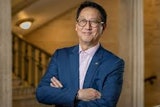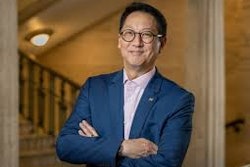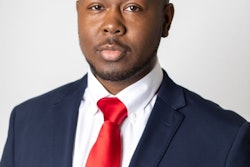Creating a Fitting Tribute Duke University Honors Historian John Hope Franklin
The idea of creating a tribute to world-renowned historian Dr. John Hope Franklin at Duke University was easy for administrators and faculty to support. Deciding what the tribute should be and raising the $20 million dollars needed to build it, however, has proven more challenging than anyone expected.
Durham, N.C.
he initial inspiration to create an entity known as the John Hope Franklin Institute came from a speech given by former newspaper columnist and University of North Carolina professor Chuck Stone, says Myrna Adams, special assistant to the executive vice president at Duke and a key player on the Franklin tribute committee. The occasion was a luncheon organized by Duke University to celebrate Franklin’s book, From Slavery To Freedom.
“In his speech, Stone said that John Hope Franklin means so much to the world and to higher education that it was incumbent upon us to do something of the same magnitude to honor Franklin,” Adams says.
So three years ago, a committee of mostly African American faculty and staff began meeting to come up with a suitable way to honor Franklin. The group included Dr. Karla Holloway, who now co-directs the new John Hope Franklin Institute. Holloway also is the dean of humanities and social sciences, and a professor of English and African American literature.
“We had been thinking for a while that it should be important for Duke to have an institutional recognition of the kind of work that Dr. Franklin did,” Holloway says.
In the meantime, Dr. Cathy N. Davidson, vice provost of interdisciplinary studies and a founding co-director of the Franklin Institute, was asked if she would help bring faculty together to create a humanities center. Not aware of the Black faculty and staff group, she says she proposed to her group that this new humanities center be named to honor Dr. John Hope Franklin.
“What happened next is pretty miraculous for academe where there are often turf wars,” Davidson says. “…Once the two groups learned they had the same goal of creating a tribute to Dr. Franklin, they met and agreed to work together on that goal. Though they were coming from two different perspectives, they agreed they could do more by joining forces to create something new, different and big. And that was a major, major step.”
Adams says that step began a six-month process of intense conversations that resulted in principles they all shared — race would be a constant focus for whatever type of center was established, and they didn’t want to focus on race only as policy but to talk about it philosophically, historically, politically, socially and internationally.
When it was suggested that a new humanities institute bear John Hope Franklin’s name, Adams says she objected because that institute’s plan didn’t bear directly on the kinds of things that they had discussed and articulated in their preliminary drafts as an African American group.
“We wanted an academy of arts and letters to be the centerpiece of this planned institute. We thought that would help us in the recruitment of Black faculty because we thought the presence of luminaries who had contributed to Black life from all over the world would be a magnet,” Adams says. “So I just said that if John Hope’s name was going to be poured over an entity that wasn’t substantively addressing the issues of African Americans that it was not satisfactory. And so we began some serious conversations about how to integrate these two things. And as far as I’m concerned,” Adams says, “those conversations continue. There is still a question of whether or not we can, in one entity, satisfy all the desires of all the various groups that are being served by it.”
Davidson gives Adams the credit for bringing all the factions together and helping them to see that they all had the same goals, especially she and Holloway, Davidson says. Holloway agrees that after she and Davidson came together, the humanities group and the African American group came together to configure the institute.
But Adams is still not convinced that what has been created puts the main focus on John Hope Franklin.
“What we now have is the John Hope Franklin Center and within that, we have the John Hope Franklin Institute. And that configuration is a compromise,” Adams says. “It’s not just a matter of naming, it’s a conceptual matter. Because in our vision, the institute was the principal feature and international programs, interdisciplinary studies and the academy would be under the institute with a board of advisors representing these parts. Instead what we have is a John Hope Franklin advisory board for the institute, but no voice in the governance of the JHF center,” Adams explains.
“The questions it raises for me are whether this was the only way to construct or reconstruct a building in the name of John Hope Franklin and was this the compromise we needed to make?” Adams says.
Presidential Support
Duke president, Dr. Nan Keohane, says that her administration has enthusiastically supported this project from the beginning.
“John Hope Franklin is one of Duke’s most illustrious, if not the most illustrious of faculty members and we wanted to honor him in a way that would recognize his broad skills and accomplishments,” Keohane says. “Yet, with a central focus on the things he cared most about — issues that had to do primarily with race but also in the broader sense with division and reconciliation. We wanted the center to be a place that would bring people together because that’s what Dr. Franklin has done.”
The center’s operations are funded by contributions from each of the programs housed in the center. Each program is supported by funds from the government, foundations and Duke University. The cost of renovation was approximately $12 million.
However, the university is still seeking donors to support the building and the various programs housed there. A fundraising effort has been launched seeking endowment opportunities and Duke has made the Franklin Center a priority in its current capital campaign. It is hoped that a donor can be found to endow the building as well as several others to endow individual programs at the center.
It is customary for campus buildings to be named after the major donor, Adams points out. Even if the building is eventually named after someone else, however, she is confident that the John Hope Franklin Institute will always be housed there.
It is not unusual in the academy for a building to have a small cornerstone bearing a donor’s name but a larger sign and common usage of a name to honor someone else, Davidson says.
“It will always be called the John Hope Franklin Center no matter who gives the money,” Davidson says, adding that the 17-foot sign out front with John Hope Franklin’s name should speak for itself.
But Adams, whose training is in law, is not so sure. Her concern is that as time passes, the sentiment about what the building should be called could change.
“If it is not put down in a legal way others not sharing the same desire to honor the man may later change it,” Adams says. “But when all is said and done, I’m happy that at the age of 85, John Hope Franklin will have lived long enough to see a center with his name and to enjoy the kind of recognition that he deserves. What we were contemplating may have taken a number of years, and maybe he wouldn’t have been with us to experience it.”
Keohane says that the larger Durham community is excited about the center.
“For years we have been trying to make clear that despite the history of segregation, Duke University is profoundly committed to reaching out to African Americans, especially because of the history of this region and this city,” Keohane says.
Dr. Bruce Kuniholm, vice provost for international studies and director of the Center for International Studies within the Franklin Center, was also a major player in creating the center and shares equally in its operation with Holloway and Davidson. He says that the center “is a fitting tribute to a great man” and hopes the center will foster the type of things Franklin has been involved with on the international level.
In February, every program in the center will sponsor an event, including workshops, exhibitions, tours of the building, a ribbon cutting ceremony and reception in tribute to Franklin and the Franklin Center. These events will coincide with the broadcast of a two-hour video documentary titled: “Tutu and Franklin,” which is scheduled to air Feb. 8, at 9 p.m., on Public Broadcasting Service (PBS) stations nationwide. In addition, a gala event will feature remarks from Bill Cosby, a vocal performance by Nnenna Freelon and comments by Franklin himself.
© Copyright 2005 by DiverseEducation.com


















